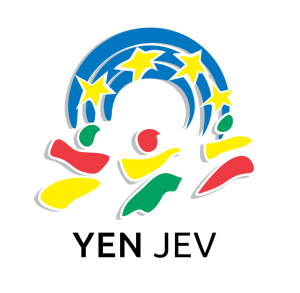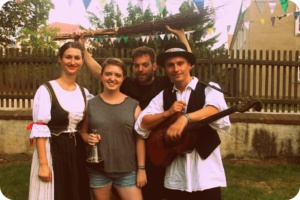Hrvatski akademski klub – HAK (Burgenland-Croats)
address: Schwindgasse 14/4
place: 1040 Wien
phone: +43-1-5057106
fax: +43-1-50463549
e-mail: info@hakovci.org
website: www.hakovci.org
Organisation
One of the main issues of the HAK – Hrvatski akademski klub, is youth work. The Club was founded in 1948 and is since then working on the promotion, preservation and development of the Burgenland-croatian language, culture and identity in Austria, as well as Hungary and Slovakia. The political basis for minority issues in Austria is the article 7 of the Austrian treaty – the HAK is constantly trying for fulfilment, improvement und adaption of the political Situation to the needs of the present time.
Minority
http://de.wikipedia.org/wiki/Burgenlandkroaten
Settlement area
All of Burgenland, Vienna, parts of today’s Slovakia and Hungary
History
After a commercial crisis in the late Middle Ages, countless epidemics, and the Turkish migrations of 1529 and 1532, a large part of the then Hungarian territories were wasted and deserted. This created the possibility for the settling of Croatian colonists. The moves were organized by the manor lords of the time (above all, the noble families Nadasdy, Erdödy and Batthany), who owned land in both former Hungary and Croatia. According to careful estimates, in 1550 about 60,000 to 150,000 Croatian settlers immigrated or were systematically moved to the region which is today the Burgenland (southwest part of Lower Austria), west Hungary, south Moravia, and southwest Slovakia. The term “Gradišæanski Hrvati/Burgenland Croat“ is a technical one, and includes not only the Croats living in today’s Burgenland, but all the Croats who emigrated to the alreadymentioned areas in the 2nd half of the 16th century. After the colonization, the Burgenlandian settlement showed the following traits: A fourth of the settlements was largely inhabited by Croats. Around 1600 the sector of Croats comprised about 25-28%. Approx. 90% of the settlers were farmers, the rest were nobility, priests, and for the smallest part, craftsmen. In the Austrian-Hungarian monarchy, there was a certain cooperation between individual settlement areas of the Burgenlandian Croats which was then destroyed by the borders drawn after WWI. The Burgenlandian Croats were distributed into three states. Almost all contacts to the Burgenlandian Croats of West Slovakia were broken after the Prague Spring, and at that time, the Croatian ethnic group did not officially exist in Slovakia. The population of the Croatian towns in south Moravia (today the Czech Republic) was deported in 1948 and the towns thereby destroyed. The official cited reason was that the Burgenlandian Croats were a politically unreliable element. Today the last representatives of this section of Burgenlandian Croats live scattered on the border of former Czechoslovakia and Poland, and some have fled to Austria or overseas. The Burgenlandian Croats of Lower Austria who formerly inhabited 60 villages were almost completely assimilated by the Austrian half of the double monarchy of the time by means of secret decrees, Croats were forbidden to speak Croatian in schools and in church, and no Croat could hold a public office.
Political Situation
The Burgenland Croats are seriously threatened by assimilation (loss of language and culture), as they are not even accorded the rights given them in the Austrian constitution (among other points, the Convention of 1955) The problem of assimilation has become especially acute due to increased mobility and continued change in commercial and social structures. While the villages and settlements were fairly compact early on from the ethnolinguistic point of view, today Croatian is losing more and more ground. The Croatianspeaking part of the population decreases continually due to the denial of minority rights, mixed marriages, day and week-shift workers, and the increasing significance of the almost exclusively German-speaking mass media. There are also various groups within the Croatian minority who pursue different interests. Some insist on rights while others want to emphasize the willingness of the Croatian population to assimilate, all of which creates a non-uniform image. In the mid-Seventies, a strong self-awareness broke through in the ethnic group of active Croats in which the politics of waiting was dimissed, and the guarantee of ethnic group rights was vehemently demanded. Some success can be observed from this. The right to use Croatian as an official language is detailed in the Constitution, and was confirmed in 1987 by the Constitutional Court. Unfortunately, bilingual officials are in short supply, as well as bilingual forms. Due to the long postponement of legalisation, it is also very difficult for many Croats to express themselves in Croatian in official proceedings, and so they prefer the German official language. A good example of the “fulfillment“ of minority rights is the town sign question. Although the Austrian constitution and ethnic group law clearly settle the question of biligual announcements in the bilingual region, there is only one (however private) bilingual sign in the village of Frankenau. Among the ethnic group political organisations are the Croatian academician club, two unions of Croatian communal politicians in the Socialdemocratic party, and the Conservative party.
Culture
The language of the Burgenland Croats (whose normatisation began in the last few decades), developed from an initial break from the mother language into its own written language form. It has not undergone the various linguistic developments which have taken place in Croatia, but has taken on elements (above all lexical) of Hungarian and German. Thanks to intensive efforts in the recent decades, it has made the jump into the 21st century, and is now a modern language. For someone who can speak Burgenland-Croatian well, conversing with a Croat from Croatia is not a problem. However, differences with respect to the written language in the Republic of Croatia prevent an effective cultural and literary exchange with the mother people. Within the Croatian ethnic group there is an active club life: there is a Croatian cultural association in the Burgenland (HKD), one in Vienna (HGKD), the Burgenland centre in Vienna (GHZ), the Cultural association (KUGA), and a culture and documentation centre (HKDC). Among town cultural mediums there are above all countless Tamburica and folklore groups in the Croatian towns, choirs, and a few pop groups and theatre groups.
Education
Through the amendment to the kindergarden law in 1989, the Croatian language became for the first time, and if only to a small degree, considered. The minority school institution in the Burgenland has been regimented through a minority school law since September of 1994. Critical points are the possibility of the discontinuation of bilingual schools and the facilitation of single language Croatian ethnic schools. The only bilingual elementary school is located in Großwarasdorf/Veliki Borištof. It is one of the most important guarantees for the continued existence of the Burgenlandian Croats in central Burgenland. However, bilingual instruction is not possible there. In September of 1992 after decades of discussion, the first bilingual high school for the Croatian and Hungarian minority in the Burgenland was founded in Oberwart/Borta, which, however, only covers 20% of the ethnic group. In addition, a school experiment of so-called “pannonic“ instruction is under way, in which three hours of language instruction in Croatian and Hungarian are given in the morning classes. In the educational field there are also two Croation ethnic colleges (HNVŠ and DOGH) and a pedagogical association (ZORA).
Media
There is a Croatian press association (HŠtD), the weekly newspaper “Hrvatske novine“, and the periodical “Novi glas“.of the HAK, which appears 2 to 5 times a year. Furthermore there is the periodical “Put“ and the church newsletter “Crikveni glasnik“. In 1979 Croatian radio broadcasts were introduced (about 45min. daily) and ten years later in 1989, the Croatian TV program “Dobar dan, Hrvati“ was broadcast for the first time (half an hour per week).
Economy
The Burgenland region is commercially underdeveloped, which also forces the Burgenland Croats to look for work outside the settlement area and to commute.
Sports
As in all of the Burgenland, in the Croatian (bilingual) towns, there are sport clubs, though in these the ethnic group plays a minor role. In Vienna the sport club SC Gradišæe is a soccer club of the HGKD.
Financial situation
Before the formation of the ethnic council, the Burgenland Croats recieved subventions of between 1,5 and 2 million Austrian Shillings from state funds. Since 1993 they have received about 15 million per year from the Austrian State Chancellor’s Office.


